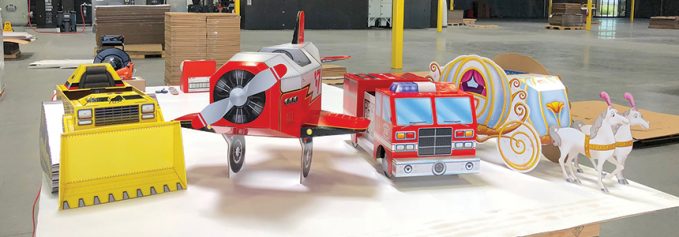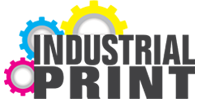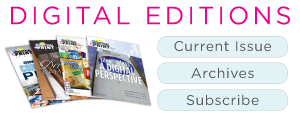
By Melissa Donovan
When tasked with a challenge smart and savvy entrepreneurs are happy to rise to the occasion. CA-based Suitables, Inc. was founded by accident October 31, 2014 when a homemade Halloween costume turned into the discovery that there was a real demand for a cardboard-like, innovative, recyclable, and fun children’s wearable.
One employee in 2014 has turned into five today, with the team operating out of a 2,000 square foot location. Suitables offers costumes that allow children to be vehicles like an airplane, diesel train, aircraft carrier, fire truck, bulldozer, Cinderella coach, or space cruiser. The designs are digitally printed onto corrugate board, with the pieces kitted and shipped directly to the consumer. An easily accessible YouTube video provides building instructions.
Mike Goedde, president and creative director/designer, Suitables, shares how digital printing shaped the journey to manufacture “the cutest and most fun cardboard costume toys you’ve ever seen.”
Above: Suitables offers customers that allow children to be an airplane, diesel train, aircraft carrier, fire truck, bulldozer, Cinderella coach, or space cruiser.
Visions to Reality
In early 2015, Goedde was learning how to bring the Suitables concept to test markets with small batches of product. Similar to how the company operates today, multiple versions of a cardboard costume were envisioned. Short runs and multiple versions—digital printing’s calling card.
However, the capabilities, speed, and quality of the digital presses available to Goedde and the Suitables team weren’t hitting all of his requirements—high quality and low cost. So he turned to offset lithography printing to achieve the quality needed.
“But then there were all the costly trappings of press plates, setup time, setup cost, and large minimum order quantities—which is not cool when you’re just starting out with a new product you want to test the market on with a small batch of product and you don’t have millions of dollars to spend on production,” admits Goedde.
Fast forward to 2018 and a visit to Essence Printing in San Francisco, CA. Goedde met with Edwin Wei, CEO, Essence Printing, who had just visited the ISA International Sign Expo. He showed Goedde a print sample from the EFI Nozomi C18000. Wei put Goedde in touch with EFI, who then had him connect with one of the only three companies in the U.S. with an EFI Nozomi C18000—Visual Impact Preprint (VIP) in Santa Teresa, NM.
VIP was instrumental in working with Goedde when it came to samples, pricing, and production planning. He says the “experience was extremely refreshing.”
Efficient and Vibrant
Suitables uses VIP to manufacture its cardboard wearables today with the help of the EFI Nozomi C18000. The decision to work with VIP and particularly the EFI printer is based on several factors.
The EFI Nozomi C18000 is a single-pass digital LED printer that outputs up to 75 linear meters per minute or 77,758 square feet per hour on substrates up to 1.8 meters wide. Its speed—setup and printing—was one of the first things Goedde noticed.
Secondly, the printer’s ability to handle gradients and other enhanced graphic effects is important. “We put a lot of effort into creating subtle, refined color gradients to simulate three-dimensional shadows and lighting in our graphic artwork for Suitables. Those gradients can be tricky for most digital printers to replicate and the EFI Nozomi C18000 does this well,” explains Goedde.
VIP runs a CMYK+W configuration on its printer, which also provides the Suitables team with options when it comes to substrate decisions. “There is a tremendous cost advantage for example to have the ability to create beautiful color images on kraft brown product mailers. We immediately saw this as a major benefit. The same benefit could also be applied to Suitables themselves to reduce cost, although we opted to print CMYK on a kemi white substrate to maximize the color vibrancy and resolution quality,” shares Goedde.
A typical Suitables run involves large 65×72-inch sheets of 44ECT E-Flute, kemi white top and kraft bottom. The EFI Nozomi C18000 can print over 500 Suitables kits in 20 minutes. Batches are queued with the EFI Fiery digital front end. Hundreds of fire trucks are printed and then immediately followed by airplanes with no interruption.
On the Back End
To keep up with the EFI Nozomi C18000’s speed, the cutting component of the production process must be equally fast. Die cutting wasn’t ideal because of the multiple SKUs available in the Suitables collection and potential for more.
“Suitables kits are highly complex and have tiny parts that can be difficult and costly for skilled die makers to produce. $2 to $5K for a single design cutting die adds more cost to the consumer pricing,” admits Goedde.
A Zünd D3 XL-3200 automated cutting table eliminates the need to create and maintain expensive cutting dies. It is equipped with double head cutting/scoring and automated feeding to provide an efficient workflow.
The 89×125-inch Zünd cutter is the ideal complement to the Suitables kitting and assembly process as well. After kits are cut, this part of the manufacturing process includes human labor. Kitting and assembly are performed on a just-cut Suitables—inline—while the Zünd D3 XL-3200 cuts the next kit.
Digital Down the Road
The fruition of Suitables is a combination of a crazy request from a kid and the innovation of digital printing technology. Without either it wouldn’t exist, and Goedde is quick to agree. “The very thing that makes the creation of Suitables possible is the intersection between digital technology and the traditional print/press industry.”
Building on the benefits of digital, specifically regarding workflow, Suitables plans to construct a web to print storefront of sorts that allows visitors to customize their products. For example, its airplane Suitables is mass produced in red and pink, but a customer may request green or blue. The online interface will allow customers to paint their own airplane, add digital stickers, and other design elements for true personalization.
Once a customer finalizes the design and submits the order, a 2D vector art file is sent to the EFI Nozomi C18000 print queue for review and printing. VIP moves the completed print to cutting, kitting, and assembly, and then drop ships to the customer.
“Just a few years ago we couldn’t have done this. It would have been too cost prohibitive and we wouldn’t have the freedom to offer this type of customization to our customers. This complete digital workflow makes this amazing innovation possible. We are excited about the future possibilities that exist for our business because of the digital revolution in happening printing,” concludes Goedde.
Sep2019, Industrial Print Magazine



